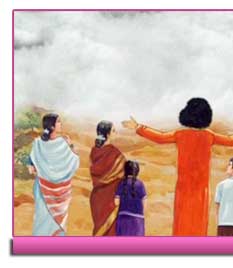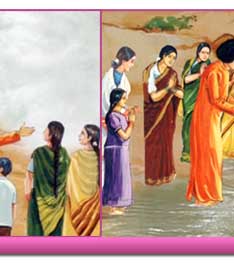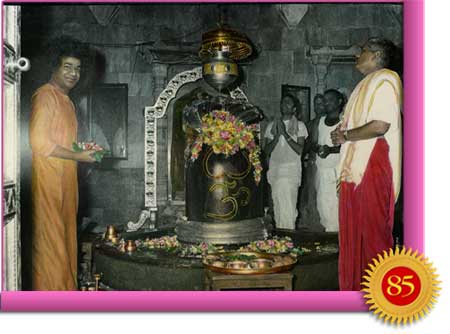LOVING LEGEND -- LIVING LEGACIES
October 20, 1940. It was on this day, seventy years ago, that Bhagavan Baba unveiled the mystery surrounding His birth, life and mission. He declared to the people around, and through them to the entire mankind, that He indeed is the Supreme Consciousness embodied in a diminutive and delightful form. “I am no longer your Sathya, I am Sai…I have My work; My devotees are calling Me…” He announced candidly on that day.Ever since, this eternal reservoir of energy and empathy, hope and happiness, solace and succor, light and love, has nursed and nurtured, and ensured that the tiny seed of goodness latent within every individual grows into a gigantic tree of love and serenity. And like a perfect teacher, He has demonstrated this more by living that principle in every moment of His own life. The result is a luminescent legacy that will continue to illumine the dark alleys of humanity’s collective consciousness, elevating it to a state of absolute sublimity for generations to come.“Loving Legend – Living Legacies” seeks to capture a few salient highlights of this glorious saga of Pure Love. This 30-episode radio documentary starts on October 20, 2010 on Radio Sai to continue daily till November 19, 2010.Below is the textual adaptation of this audio series embellished with pictures, audio and video clips!Let us immerse ourselves in the story of His glory and more important strive to make our little lives shine with the sacred glow of purity, nobility and genuine compassion.Episode 16: Reawakening the Sacred Somnath
 |
|
In the earlier episodes of this series we brought accounts of how Baba made a landmark visit to Badrinath and various other shrines in North India. The purpose of these trips was to recharge the spiritual batteries of the holy temples of India as part of His mission towards the reestablishment of dharma.
In this issue of H2H, He ignites with divine potency the sacred shrine of lord Shiva in Somnath, in the state of Gujarat in West India.
When Bhagavan journeys from Puttaparthi, the experiences of the devotees who accompany Him are often filled with His magical play leading to an ecstasy divine.
In this issue of H2H, He ignites with divine potency the sacred shrine of lord Shiva in Somnath, in the state of Gujarat in West India.
When Bhagavan journeys from Puttaparthi, the experiences of the devotees who accompany Him are often filled with His magical play leading to an ecstasy divine.
The Oceans Offer Obeisance to the Lord
In a previous episode, we had recounted an incident that took place during His trip to Kanyakumari, where three seas meet at the southern-most tip of India. It was evening, the sky had turned into a carnival of pink and purple, and the clouds had decorated themselves with a golden fringe. Baba walked towards the seashore with His companions. Each succeeding wave that lapped upon the shore seemed more eager than its predecessor to touch His lotus feet.
 |  |  |
Suddenly, as if aware of the yearning of the seas, Baba turned, faced the waters and said to those beside him: “See! The ocean is welcoming Me with a garland.”
A few yards away, a stately wave was advancing majestically towards the shore.
Soon it swept over Baba's Feet. When the wave receded, encircling the ankles of the Avatar was a bewitching pearl garland, swaying with the gentle surge of the waters around it. These pearls were translucent and priceless, held together by a golden thread. Their number was exactly 108.
Such were the divine happenings that kept devotees enthralled and enchanted.
Even the Inanimate Yearn for God
 |
Early in the afternoon on 9 May 1970, Baba left Brindavan for Bombay. The entourage comprised three cars, the last one being a carefully reconditioned one brought by two members of the Seva Samithi who had come to escort Baba and His party. Baba questioned the Samithi members at more than usual length on the details of the repairs done, and the two assured Him that all was well.
When about 30 miles had been traversed, something from the car fell on the road with a thud. The vigilant chauffeur stopped the car, retrieved the part and quietly put it under his feet as if it were a superfluous gadget. Nearly 50 miles off, he heard a squeak; he stopped and lifted the hood to peep inside and assured himself that all was well. A few miles further, he halted again and sniffed a little. He got out of the car and went around it and with an expression of audacious courage, hopped in again and started off.
Late Prof. Kasturi being one of the passengers commented: “The friends from Bombay who were with me were unconcerned. But, my nervousness increased with every interruption.”
A little distance away, they came upon Baba parked at a lonely spot by the side of the road. Kasturi pleaded with Baba that he may be shifted to another car, for he believed the vehicle to be fast disintegrating. Baba with a chuckle described a performance often given by clowns in circuses: they go round and round the ring in a car as its parts fall off one by one. Finally, they find themselves squatting on the ground.
Baba said: “Don't worry. If you fall out, we shall make sure that someone picks you up and puts you back in.”
The car behaved well, reaching Dharwar some 250 miles further off at one in the morning.
 |
After resting, they proceeded in the same car to Poona and then to Bombay without a squeak or a spasm. At Bombay, when it was sent to the workshop for servicing, the mechanic asked the chauffeur: "How did those who came in this car reach Bombay alive? The spring plates of the front wheels are cracked!"
Kasturi was present when the owner of the car was relating this miracle to Baba, and as if by explanation he said, "The driver is a devotee." Kasturi was quick to add: “The occupants are also devotees, Baba!”
Baba: “Not you. The car is the devotee, a great devotee!”
He explained that the car had a personality. It had prayed for Grace and received it. He said: “In fact, every artifact has human feelings. Machines get tired. Even mountains weep.”
At Bombay, later, He asked someone to bring for His selection and purchase some saris to be given as gifts to the women labourers who had helped build the Sathya Sai College at Anantapur. He selected 96 and rejected four. He kept the discarded ones apart, so that they could be returned.
When Baba returned an hour later, he found signs of tears on the table where the rejected saris were kept. Calling our attention to this, He said: “Poor things. They are sorry I kept them aside. All right. I shall take them also to Anantapur with Me.”
 |
Months later, He repeated this incident at a meeting at Prashanti Nilayam when He was describing the Puranic story of the Govardhana Hill. “Rama decided to build a bridge over the sea to Lanka. The divine monkeys in His army pulled huge mountains up by their roots and passed them along the conveyor belt of monkeys, shoulder to shoulder, until they were dropped into the sea. Upon completion of the bridge, some of the peaks were no longer required. So each monkey dropped in place whatever it had and hurried off to the bridge. One mountain that had been plucked from its native spot and brought some distance away started weeping. Rama heard its wail and consoled it saying, ‘Stay! I shall use you when I incarnate next and hold you as an umbrella to save the Yadavas from the anger of God Indra.’ The hill that wept was Govardhan.”
In Bombay, a huge gathering waited for Baba’s address on 12 May 1970, exactly two years to the day of the inauguration of the Dharmakshetra.
At the time, newspapers were carrying headlines of the Hindu-Muslim riots in Bhiwandi. Referring to these and the emergence of faith in violence as a solution to the problems of life, Baba said: “Look at a tree. The roots, the trunk, the branches, the twigs, the bark, the timber, the pith, the sap, the leaf, the bud, blossom and fruit, the seed - each has a distinct taste, colour, feel, smell and shine. But, you do not deny that they are all from the same seed. Each has its separate use and function. All have been fostered by earth and sun. ‘I am the seed of all Creation,’ says the Lord in the Bhagwad Gita. It is a pity that man is indulging in the arts of slander and faction, mudslinging and character assassination, hatred and war so that his ego might be satisfied. Love is the best balm to quiet anger.”
Sai Someswara Recharges the Somnath Linga
On the fifteenth, Baba left for several sites on the Kathiawar Peninsula in Gujarat.
On 17 May, He arrived at Somnath, located on the Arabian Sea. Somnath is situated on a spot celebrated in the Vedas and epics. It was one of the richest temples of India. When the Muslims conquered and ruled the Punjab and Sindh, the temple attracted the plunderers. Depredation, desecration, destruction, reconstruction and rededication became recurring chapters of its long history. The infamous raid by Mahmud of Ghazni in 1026 AD was the third in the long list of catastrophes. The fifth temple too met with a similar fate, at the hands of the Sultan of Delhi.
 |
On Diwali Day in 1947, the Indian army liberated the area that included the pathetically dismal pile of stones recognised by many as Somnath. It was rescued from those who could not appreciate the value and validity of idols, images and symbols of the Unknown and the Unknowable. Sardar Vallabhbhai Patel, the Deputy Prime Minister of India, announced that day, amidst the joyous roar of the waves of human and saline seas: "We have decided that Somnath should be reconstructed. This is a holy task in which all should participate."
Soma is a contraction of ‘Sa’ and ‘Uma’, a designation of Siva-Sakthi. Now, the Gopuram, the main gateway through which seekers would enter into the portals of Somanath, was to be inaugurated by Someswara Himself - Siva-Sakthi in human form come as Sathya Sai.
Baba declared He would reveal that day the genuine Somnath. This declaration filled all with wonder and enthusiastic exuberance. So, all roads converging from Jamnagar to Somnath were lined with people shouting Jais in exhilaration. Baba was received at the decorated shamiana in front of the Gopuram by the trustees of the Temple. Amidst strains of temple music, He walked on the red carpet laid on the steps and opened the lock on the artistically carved and silver-embossed door with a silver key. Then, He proceeded along the festooned pathway, between rows of fresh banana trees, to the main shrine of Someshwar, the focal point of the faith of millions for millennia!
He entered the Holy of Holies. Brahmin pundits were reciting Vedic hymns that reverberated from the arched and conical roof 150 feet above the ground. Baba directed that a silver plate be brought. He spread the fingers of His right hand and shook it over the plate; 108 silver bilva leaves and an equal number of golden flowers fell from His hand in a clinking shower. They were reverentially touched by devotees for it is on their behalf and for their sake that the process of charging the three-foot high lingam was being undertaken. This lingam had been installed when the temple was inaugurated in recent times. Now Baba poured the leaves of silver and flowers of gold on the lingam.
 |
Prof. Kasturi narrates in his biography of Baba: “Then with a wave of that divine hand, behold! A ball of brilliant light manifested in His palm. I was at that time reciting within myself the verses in praise of the 12 ‘Lingas of Light’ which every Hindu is exhorted to remember reverentially. The very first in the list is Sowrashtra Somnatha. The Somnatha Linga is the only one of the 12 that is adored as Jyothirmayam, imbued with the splendour of light. And, Baba had the Linga of Light right now in His grasp. What a great moment, I wondered. Then I remembered Baba's announcement ‘I shall show you the genuine Somnath today.’
In a pamphlet issued by the tourist department, it is said that Skanda Purana mentioned thousands of years ago that the lingam of Somnath is a self-originated lingam, of great prowess, as bright as the sun, of the size of an egg of a hen, which is situated underground. It is a characteristic of Vayu (air). Other lingas represent the other elements.
The oval ball of light in Baba’s hand was the authentic Somesvara. He had resolved to bring it up from its underground niche, kept away for many centuries from depredation and desecration. The lingam was nestling for thousands of years under the observed lingam in the shrine. This information was given to us by Baba, as well as by the priests and trustees. Baba waved His Hand again and created a silver stand on which it could be placed. He gave it to the Chief Priest, saying,
“Let it be in the full light of day hereafter. Let pious eyes admire its brilliance and imprint its glory on their hearts. There is no need any more to keep it away. The Avatar has come to remove all fear.”
Baba raised the flag over the central shrine in a symbolic gesture of the triumphant emergence of Somesvara. Then to the cheer of “Jai Bhagawan” from thousands of lips, Baba left Somnath at 2.00 in the afternoon.
(To be continued)
- Heart2Heart TeamWhat are your impressions about this article? Please share your feedback by writing to h2h@radiosai.org. Do not forget to mention your name and country.























No hay comentarios :
Publicar un comentario